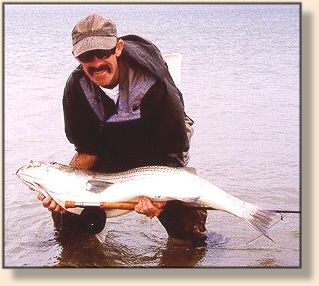Rich Murphy's Pamet Special
By Rich Murphy
I developed the prototype of this pattern while on an October vacation
to Truro, Massachusetts in 1989. My intent then was to develop a large
sand eel imitation I could use to capitalize on the striped bass blitzes that
are routine during the fall months at the mouth of the Pamet River when,
during the ebb of the tide, literally tons of sand eels are flushed into
Massachusetts Bay.
The prototype lay-up used a non-descript 3/0 stainless hook, three saddle
hackles in the tail construction, an olive over pink bucktail wing and a five
minute epoxy head with pearl and red Krystal Flash highlights. The prototype
swam and breathed very well, and caught lots of fish.
The current model, Rich Murphy's concept, uses natural hair instead
of hackles as a primary tail material (yak, polar bear, or buck tail)
The illustrated example is tied with natural polar bear. Hair is
more durable, less prone to fouling and mung accumulation than
feathers. The current model also uses an EZ Body
head that can be replaced as required without trashing the rest of the fly. I
prefer to tie it on 3/0 or 4/0 high carbon steel hooks, like TMC 600s, Owner AKI,
Gamakatsu SC15-2H, or Trey Combs Big Game. High carbon hooks are
harder than stainless hooks so they will hold a keener cutting point longer.
Materials: Pamet Special
Hook: 3/0 or 4/0 hook. An 3/0 Owner AKI is used in the
procedure illustrations
Thread: Fine monofilament.
Tail: Bucktail, polar bear, or yak and Crystal Flash.
Wing: Bucktail, olive, dark olive and pale lavender.
Body and throat: Krystal Flash.
Head: EZ Body.
Tying Steps:
1. Select a 3/0 or 4/0 hook of your choice. I prefer using TMC 600, Owner Aki, Gamakatsu SC15-2H, or Trey
Combs Big Game hooks myself. An 3/0 Owner AKI is used in the procedure illustrations. Barrel wrap the
hook shank with fine monofilament thread from the base of the hook eye to the beginning of the bend of the
hook.
2.Tie in a tail consisting of a 1/8" diameter bunch of light pink bucktail (3 ½ - 5" in length) over seven strands of
gray ghost Krystal Flash over a ¼ " diameter bunch of natural yak, polar bear, or white bucktail, 4-8 " in
length. Add a drop of super glue to the joint. In Figure 1 and the rest of the illustrations, natural polar bear is
used as the primary tail material.

3. Tie in a wing consisting of a 1/16" diameter bunch olive pale olive bucktail (4-6" in length) over a 1/16"
diameter bunch of dark olive bucktail (4-6" in length) over of a 1/16" diameter bunch of pale lavender bucktail
(3 ½ - 5 " in length) over the tail assembly as shown in Figure 2. Add a drop of superglue to the joint.
|










